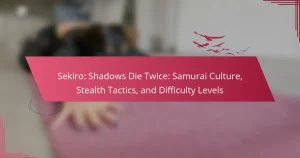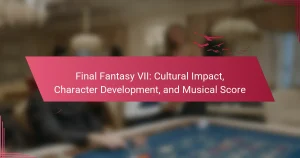Nioh offers a challenging blend of historical accuracy and mythical storytelling, engaging players with its intricate combat mechanics and rich cultural backdrop. The game draws inspiration from Japan’s Sengoku period, featuring real-life samurai and significant battles. Players must master complex combat systems while facing formidable Yokai from Japanese folklore. This unique combination enhances the immersive experience and depth of gameplay.

What are the Historical Inspirations Behind Nioh?
Nioh draws heavily from historical events and figures, particularly the Sengoku period in Japan. The game incorporates real-life samurai, battles, and cultural elements, blending them with mythological aspects. Notable inspirations include the famous samurai Yoshitsune and the battle of Sekigahara, which shaped Japan’s history. These elements enrich the game’s narrative and combat mechanics, creating a unique experience that reflects Japan’s rich heritage.
How Does Japanese History Influence Nioh’s Narrative?
Japanese history significantly shapes Nioh’s narrative through its incorporation of historical figures, events, and cultural elements. The game features characters like William Adams, a real-life Englishman who navigated the tumultuous Sengoku period. This historical backdrop enriches the storyline, blending fact with fiction.
Additionally, Nioh integrates Japanese mythology, introducing mythical creatures such as yokai. These entities reflect traditional beliefs and enhance the game’s immersive experience. The combat mechanics are influenced by samurai culture, emphasizing skill and honour, mirroring the historical context of warfare in Japan.
Overall, Nioh’s narrative serves as a bridge connecting players to Japan’s rich history and folklore, creating a unique gaming experience that honours its roots.
Which Historical Figures are Featured in Nioh?
Nioh features several historical figures, including William Adams, Tokugawa Ieyasu, and Oda Nobunaga. These characters embody key elements of Japan’s Sengoku period, blending history with mythology. Players encounter them as both allies and adversaries, enhancing the game’s narrative depth. The inclusion of these figures enriches the combat mechanics, allowing for unique interactions and challenges.
What Role Does the Sengoku Period Play in the Game’s Setting?
The Sengoku Period plays a crucial role in Nioh’s setting, providing a rich historical backdrop. This era of intense social upheaval and military conflict influences the game’s narrative, character development, and combat mechanics. Players encounter historical figures and factions, enhancing immersion. The chaotic atmosphere of the Sengoku Period mirrors the game’s challenging gameplay, where players navigate battles and mythical creatures. This historical context deepens the player’s experience, intertwining reality with the supernatural elements of the game.
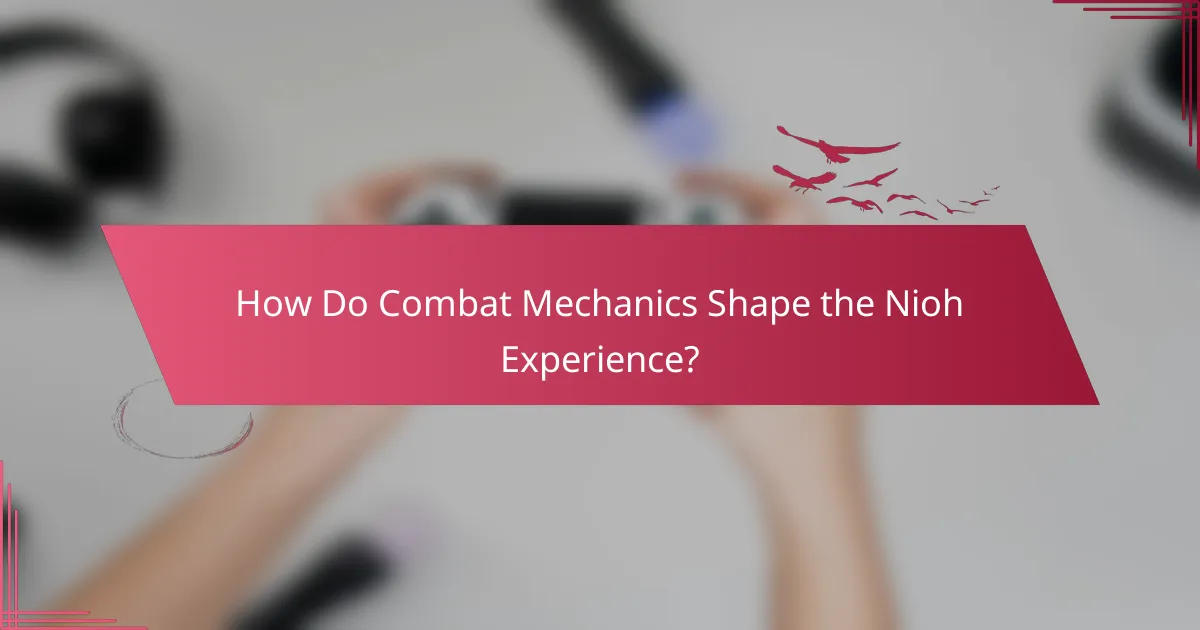
How Do Combat Mechanics Shape the Nioh Experience?
Combat mechanics significantly shape the Nioh experience by offering strategic depth and fluidity in gameplay. Players engage in a complex system that includes stances, ki management, and weapon variety, fostering tactical decision-making. The game’s historical inspirations are reflected in the combat style, which emphasizes precision and timing, mirroring samurai combat techniques. Unique attributes, such as the ability to switch between stances, allow players to adapt to different enemy types effectively. This dynamic combat system enhances player immersion and creates a rich, engaging experience that resonates with the game’s overall themes.
What are the Key Combat Styles Available to Players?
Nioh offers players a variety of combat styles that enhance gameplay. The key styles include Samurai, Ninja, and Onmyo Magic, each with unique mechanics and abilities. Samurai focuses on powerful melee attacks, Ninja emphasizes agility and stealth tactics, while Onmyo Magic provides elemental spells and support skills. These styles allow for diverse strategies and character customization, catering to different play preferences. Players can mix and match techniques to create a personalized combat experience.
How Does Stamina Management Affect Combat Strategy?
Stamina management significantly influences combat strategy in Nioh by dictating the pace and style of engagement. Effective stamina control allows players to execute attacks, dodge, and block effectively, enhancing overall performance in battles.
Players must balance aggressive tactics with defensive maneuvers, as stamina depletion can leave them vulnerable. Properly timed attacks and strategic retreats capitalize on stamina levels, allowing for sustained combat effectiveness.
Additionally, unique abilities and weapon types in Nioh interact with stamina mechanics, adding depth to combat strategy. Understanding these interactions can lead to more effective gameplay, particularly against formidable foes.
In summary, managing stamina is crucial for optimizing combat strategies, ensuring players can adapt to various challenges in the game.
What Unique Features Set Nioh’s Combat Apart from Other Action RPGs?
Nioh’s combat stands out due to its intricate stance system, skill-based mechanics, and deep integration of Japanese mythology. Players can switch between stances—high, mid, and low—to adapt to different enemy types and situations. This flexibility enhances strategic depth, allowing for diverse combat styles. The game also emphasizes precision, rewarding players for mastering timing and skillful dodging. Additionally, the presence of Yokai and other mythical creatures introduces unique abilities and challenges, further enriching the combat experience. Overall, Nioh’s combat mechanics create a distinctive blend of tactical gameplay and cultural storytelling.
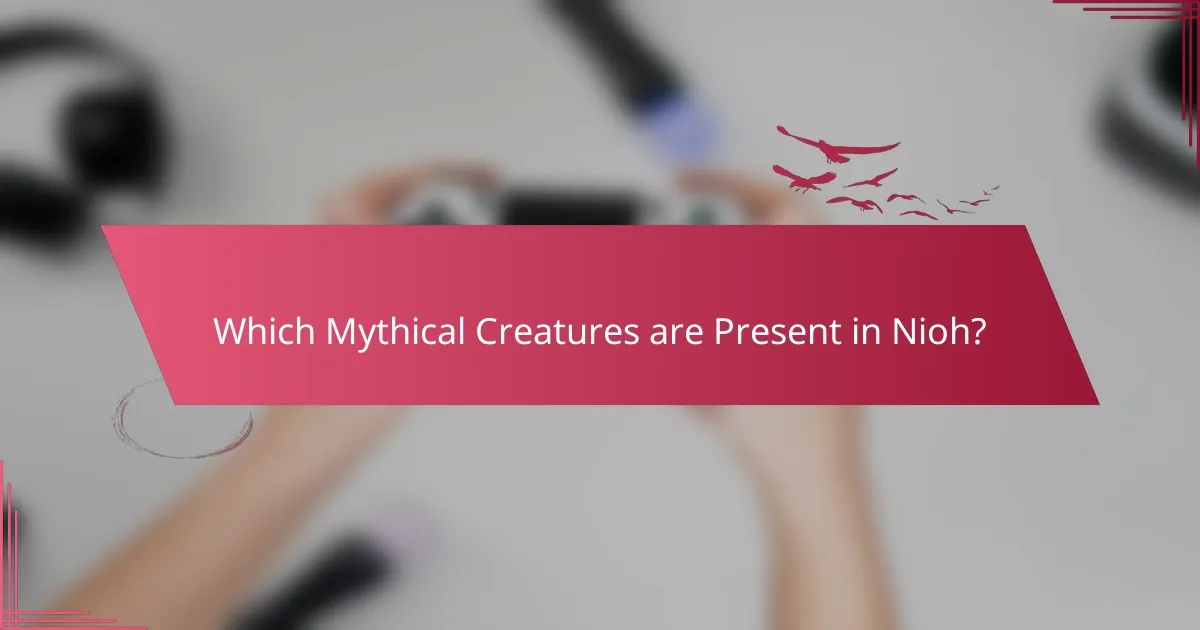
Which Mythical Creatures are Present in Nioh?
Nioh features various mythical creatures inspired by Japanese folklore. Notable entities include Yokai like Tengu, Oni, and Kappa, each possessing unique abilities and characteristics. Yokai serve as formidable adversaries, enhancing the game’s combat mechanics and narrative depth.
How are Yokai Represented in Nioh’s Gameplay?
Yokai in Nioh’s gameplay are represented through unique enemy designs, abilities, and lore that reflect their mythological origins. Each Yokai features distinct combat mechanics, enhancing the game’s challenge and atmosphere. For example, the Shishin, a spirit resembling a lion, exhibits powerful attacks and requires specific strategies to defeat. Furthermore, Yokai transformations allow players to harness their powers, blending the supernatural with combat. This integration deepens the historical and cultural context of the game, enriching player experience.
What is the Significance of Japanese Folklore in Nioh’s Creature Design?
Japanese folklore significantly influences Nioh’s creature design, enriching the game with depth and authenticity. The developers draw inspiration from various mythological beings, such as yokai and kami, which embody cultural beliefs and fears. This connection to folklore enhances the gameplay experience, as players encounter creatures that reflect the historical and spiritual landscape of Japan. The unique attributes of these mythical beings, including their origins and characteristics, add layers of complexity to the game’s narrative and combat mechanics. As a result, Nioh not only entertains but also serves as a gateway to understanding Japanese cultural heritage.
How Do Mythical Creatures Influence Combat Encounters?
Mythical creatures significantly enhance combat encounters in Nioh by adding unique abilities and challenges. These entities, rooted in Japanese folklore, introduce diverse combat mechanics that require players to adapt their strategies. For example, encountering a Tengu may necessitate aerial tactics, while a Yuki-onna could involve ice-based attacks. Each creature’s distinct attributes shape the gameplay experience, making encounters both unpredictable and engaging. This integration of mythology not only enriches the narrative but also deepens player immersion in the historical setting.
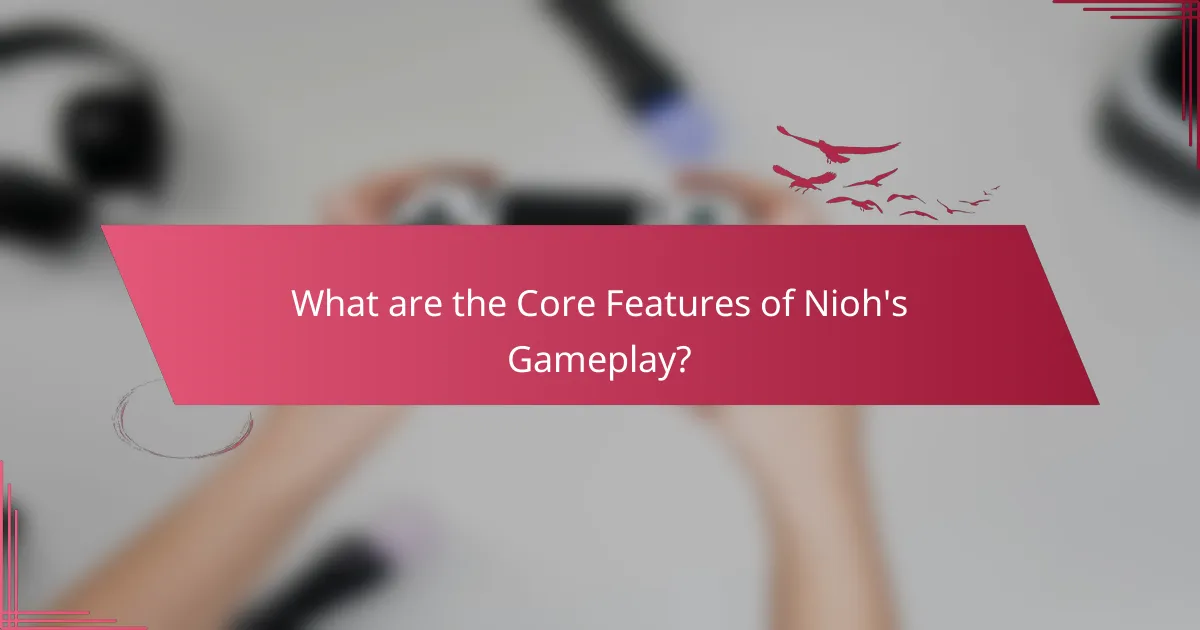
What are the Core Features of Nioh’s Gameplay?
Nioh’s gameplay features complex combat mechanics, historical inspirations, and mythical creatures. Players engage in intense battles using a variety of weapons and techniques. The game emphasizes stamina management and strategic attacks, allowing for deep customization of character builds. Richly detailed environments reflect Japan’s Sengoku period, enhancing immersion. Unique enemies, including legendary yokai, add to the challenge and lore.
How Does Equipment and Customization Enhance Player Experience?
Equipment and customization significantly enhance player experience in Nioh by allowing tailored gameplay. Players can select weapons, armor, and skills that suit their combat style, fostering personal investment. Unique equipment attributes, such as elemental affinities and stat boosts, further enrich the gameplay. Customization options, including appearance and playstyle adjustments, create a deeper connection to the game world, enhancing immersion and enjoyment.
What Role Does Co-op Play in Nioh’s Multiplayer Experience?
Co-op play enhances Nioh’s multiplayer experience by allowing players to team up against formidable foes. This collaborative approach fosters strategic combat, where players can combine their strengths to tackle challenging missions. Cooperative gameplay also introduces unique mechanics, such as shared resources and revives, which deepen engagement. Players can summon allies to assist in battles, creating a dynamic environment that emphasizes teamwork. The blend of historical inspirations and mythical elements further enriches the cooperative experience, making it a vital aspect of Nioh’s appeal.

How Does Nioh Compare to Other Action RPGs?
Nioh stands out among action RPGs due to its unique blend of historical inspirations, intricate combat mechanics, and mythical creatures. The game’s setting draws heavily from Japanese history, particularly the Sengoku period, which adds depth to its narrative. Combat mechanics in Nioh emphasize skill and strategy, requiring players to master various stances and weapon types. This complexity contrasts with other action RPGs that may prioritize simpler combat systems. Additionally, Nioh features a diverse array of mythical creatures, known as Yokai, which enrich the gameplay experience and differentiate it from other titles in the genre.
What Similarities and Differences Exist Between Nioh and Dark Souls?
Nioh and Dark Souls share similarities in their challenging gameplay and intricate world-building, yet differ significantly in combat mechanics and historical context. Nioh emphasizes fast-paced, skill-based combat inspired by Japanese history, while Dark Souls focuses on methodical, strategic gameplay rooted in dark fantasy. Both games feature intricate lore and interconnected environments, but Nioh incorporates mythical creatures from Japanese folklore, adding a unique cultural dimension absent in Dark Souls.
Which Elements Make Nioh Unique Among Its Peers?
Nioh stands out due to its blend of historical inspirations, intricate combat mechanics, and unique mythical creatures. The game draws heavily from Japanese history, particularly the Sengoku period, which adds depth to its narrative. Combat mechanics are finely tuned, emphasizing skill and strategy, with a stamina-based system that encourages precise timing. Additionally, the incorporation of yokai and other mythical beings enriches the gameplay experience, providing players with diverse challenges and lore. This combination of elements creates a distinct identity that sets Nioh apart from its peers.

What Challenges Do Players Face in Nioh?
Players in Nioh face challenges such as difficult combat mechanics, resource management, and navigating complex environments. The game features intense enemy encounters that require skillful timing and strategy. Players must also contend with the stamina system, which limits their actions during battles. Additionally, the presence of mythical creatures adds unpredictability, demanding adaptability and quick thinking. Balancing offensive and defensive tactics is crucial for survival in this challenging setting.
How Can Players Overcome Difficult Boss Fights?
Players can overcome difficult boss fights in Nioh by mastering combat mechanics and utilizing effective strategies. Focus on learning enemy patterns to anticipate attacks. Use the right weapons and skills that exploit the boss’s weaknesses. Timing is crucial; dodge or block effectively to avoid damage. Enhance your character’s abilities through leveling up and acquiring gear that boosts critical attributes. Consider summoning allies for support during challenging encounters.
What Common Mistakes Should Players Avoid?
Players should avoid common mistakes like neglecting character builds, underestimating enemy types, and ignoring environmental cues. Focusing on skill upgrades enhances combat effectiveness. Understanding the game’s historical inspirations can provide strategic advantages. Learning enemy patterns reduces unnecessary deaths, improving overall gameplay experience.
What Strategies Can Enhance Player Progression?
To enhance player progression in Nioh, focus on mastering combat mechanics, optimizing character builds, and utilizing the game’s unique loot system. Combat proficiency is vital; learn enemy patterns and effective weapon combinations. Invest in skills that complement your playstyle, whether through strength, agility, or magic. Engaging with the loot system allows players to acquire powerful gear, enhancing stats and abilities. Additionally, participating in co-op play can provide valuable experience and resources, accelerating progression.

What Future Developments Can We Expect for Nioh?
Future developments for Nioh will likely focus on enhanced combat mechanics, deeper historical narratives, and expanded mythical creature interactions. The franchise may explore new settings inspired by Japanese folklore, integrating unique attributes to enrich gameplay. Additionally, advancements in graphics and AI could elevate player immersion, allowing for more dynamic encounters. As a result, players can expect a blend of familiar and innovative elements in upcoming titles.
How Might Nioh Influence Future Action RPGs?
Nioh may significantly influence future action RPGs by setting new standards in combat mechanics and integrating historical narratives. Its unique blend of Japanese mythology and samurai culture provides a rich backdrop that future developers can explore. Nioh’s fast-paced, strategic combat emphasizes skill and timing, encouraging similar mechanics in upcoming titles. Additionally, the game’s intricate enemy designs, inspired by folklore, can inspire more diverse and engaging creature designs in the genre. These elements collectively enhance player immersion and challenge, shaping the evolution of action RPGs.
What Are the Community’s Expectations for Nioh’s Next Installment?
The community expects Nioh’s next installment to enhance combat mechanics, deepen historical narratives, and introduce new mythical creatures. Players desire improved character customization and cooperative gameplay features. Additionally, they hope for a more immersive world with richer environments and lore. Balancing difficulty remains a key expectation, ensuring challenges for both new and veteran players.
What Best Practices Should Players Follow to Master Nioh?
To master Nioh, players should focus on understanding combat mechanics, utilizing character builds, and studying enemy patterns. Prioritize learning weapon types and their strengths. Experiment with different skills and magic to enhance versatility. Adapt strategies based on historical inspirations and mythical creature behaviors. Regular practice and patience are essential for improvement.
